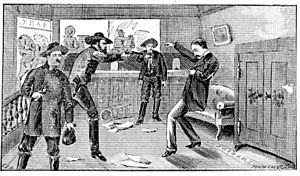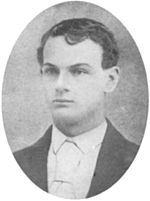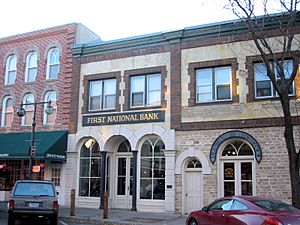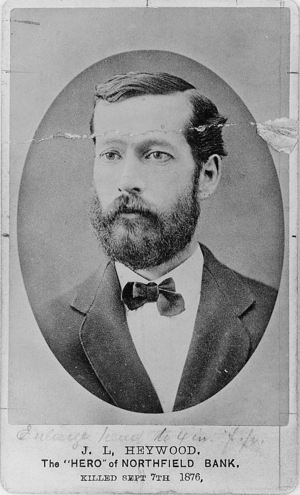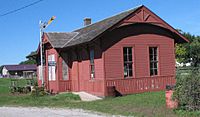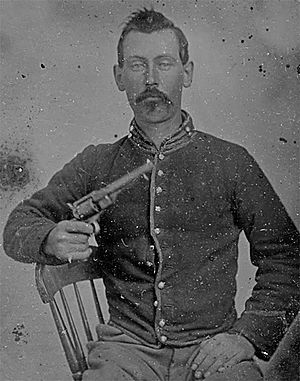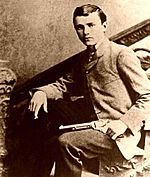James–Younger Gang facts for kids
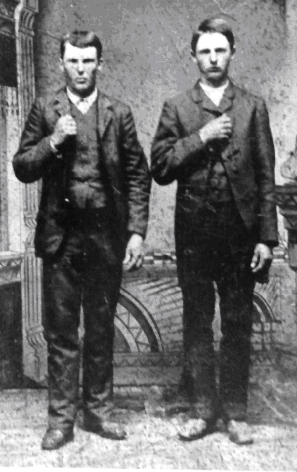
Jesse and Frank James, 1872
|
|
| Named after | |
|---|---|
| Formation | 1861 |
| Dissolved | September 7, 1881 |
| Location | |
| Methods | Robbery |
The James–Younger Gang was a famous group of American outlaws in the 1800s. It was led by brothers Jesse James and Frank James. Most of the gang members lived in Missouri.
The people in the gang changed often because their robberies were usually months apart. Besides the famous James brothers, the gang also included the Younger brothers (Cole, Jim, John, and Bob). Other members included John Jarrett, Arthur McCoy, George Shepherd, Oliver Shepherd, William McDaniel, Tom McDaniel, Clell Miller, Charlie Pitts, and Bill Chadwell.
The James–Younger Gang started from a group of Confederate fighters called "bushwhackers". These fighters were involved in battles in Missouri during the American Civil War. After the war, these men continued to rob and commit crimes. But now, they did it for money, not for the Confederacy. The group officially became the "James–Younger Gang" around 1868. This was when authorities first named Cole Younger and others as suspects in a bank robbery in Russellville, Kentucky.
The James–Younger Gang broke up in 1876. This happened after the Younger brothers were caught in Minnesota. They had tried to rob the First National Bank in Northfield. Three years later, Jesse James started a new gang. This new gang included Clell Miller's brother Ed and the Ford brothers (Robert and Charles). Jesse continued his criminal life. But it ended in 1882 when Robert Ford shot and killed him.
For almost ten years after the Civil War, the James–Younger Gang was one of the most feared groups of outlaws. They were also very famous and wanted in the American frontier. Even though their crimes were dangerous and violent, many people supported the gang. The gang robbed banks, trains, and stagecoaches. They committed crimes in at least eleven states, including Missouri, Kentucky, and Minnesota.
Contents
How the Gang Started
The Civil War Years
At the start of the American Civil War, Missouri chose to stay neutral. But the state had many strong supporters for both sides. By late 1861, guerrilla fighting broke out. This was between Confederate bushwhackers and Union forces. The conflict was very violent. Both sides committed terrible acts. Union troops sometimes executed suspects. Bushwhackers often killed Unionist farmers.
The James and Younger brothers came from families in western Missouri. These families strongly supported the South. Cole Younger's father was killed by Union forces in 1862. This led Cole to become a bushwhacker. He and Frank James fought under a famous Confederate bushwhacker named William Clarke Quantrill. Jesse James started fighting in 1864 when he was 16. He fought alongside Frank.
When the war ended, Frank James surrendered. Jesse James tried to surrender but was shot. His cousin, Zerelda "Zee" Mimms, helped him recover. Jesse later married her. The James brothers continued to spend time with their old fighter friends. These friends stayed together under Archie Clement. It was likely Clement who turned these fighters into outlaws. This happened during the difficult time of Reconstruction in Missouri.
Early Robberies: 1866 to 1870
On February 12, 1866, a group of gunmen robbed the Clay County Savings Association in Liberty, Missouri. They stole about $60,000. A person named George Wymore was killed outside the bank. Authorities thought Archie Clement led the robbery. They offered a reward for him. Later, Jesse and Frank James, Cole Younger, and others were also suspected.
The gang started a series of robberies. Many of these were linked to Clement's group. On October 30, 1866, they robbed Alexander Mitchell and Company in Lexington, Missouri. They took over $2,000. Clement was also known for threatening Republican officials. He even led his men to scare Republican voters away from the polls. State soldiers were sent to capture Clement. He refused to give up and was killed in a gunfight.
Even after Clement's death, his followers stayed together. They robbed a bank in Richmond, Missouri, on May 22, 1867. The town mayor and two lawmen were killed. On March 20, 1868, they raided the Nimrod Long bank in Russellville, Kentucky. After these raids, many older bushwhackers were killed or left the group. This allowed the James and Younger brothers to become the main leaders. This is when the group truly became the James–Younger Gang.
On December 7, 1869, Frank and Jesse James likely robbed the Daviess County Savings Association in Gallatin, Missouri. Jesse may have shot the cashier, John W. Sheets. He thought Sheets was Samuel P. Cox, a Union officer who had killed "Bloody Bill" Anderson. The James brothers were not well-known before this. This might have been their first robbery.
More Robberies: 1871 to 1873
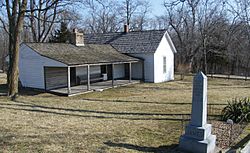
In January 1871, John Younger almost got arrested in Dallas County, Texas. He killed two lawmen and escaped. On June 3, 1871, the gang robbed a bank in Corydon, Iowa. The James and Younger brothers were suspects. The bank hired the Pinkerton National Detective Agency. Allan Pinkerton sent his son, Robert, to track the gang. A gunfight happened, but the gang escaped. Jesse James later wrote a letter to a newspaper. He claimed Republicans were targeting him because he supported the Confederacy.
On April 29, 1872, the gang robbed a bank in Columbia, Kentucky. One outlaw shot the cashier who would not open the safe. On September 23, 1872, three men robbed a ticket booth at an event in Kansas City. They took about $900. A little girl was accidentally shot. Jesse James denied he or the Youngers were involved. The Kansas City Times newspaper praised the crime. The editor, John Newman Edwards, published a letter from an outlaw. It said, "They rob the poor and rich, and we rob the rich and give to the poor."
On May 27, 1873, the James–Younger Gang robbed the Ste. Genevieve Savings Association in Ste. Genevieve, Missouri. As they left, they shouted, "Hurrah for Hildebrand!" Samuel S. Hildebrand was a famous Confederate bushwhacker who had recently died. Arthur McCoy, who knew the area well, was likely involved in planning this robbery.
On July 21, 1873, the gang robbed a train. They derailed a Rock Island Railroad train near Adair, Iowa. The engineer died in the crash. The outlaws took $2,337 from the baggage car. They just missed a much larger shipment of cash.
In November 1873, John Newman Edwards wrote a long article praising the James brothers, Cole and John Younger, and Arthur McCoy. The article focused on Jesse James and their Confederate loyalties.
The Final Years of the Gang: 1874 to 1876
In January 1874, the outlaws were suspected of robbing a stagecoach in Bienville Parish, Louisiana. Another stagecoach robbery happened in Arkansas. There, the gang gave a pocket watch back to a Confederate veteran. They said Northern men had forced them to become outlaws. On January 31, the gang robbed a train on the Iron Mountain Railway at Gads Hill, Missouri. They robbed the passengers. They reportedly checked passengers' hands to make sure they did not rob working men. Many newspapers said the "Arthur McCoy" gang did this. The gang even sent a telegram about the robbery to a newspaper.
The Adams Express Company, whose safe was robbed at Gads Hill, hired the Pinkerton National Detective Agency. On March 11, 1874, Pinkerton agent John W. Whicher was found shot to death in Jackson County, Missouri. Two other agents, John Boyle and Louis J. Lull, tracked the Youngers. On March 17, 1874, John and Jim Younger attacked them. A deputy sheriff was killed. Lull and John Younger shot and killed each other. Boyle and Jim Younger escaped.
The deaths of the Pinkerton agents caused problems for Missouri's governor. He offered a $2,000 reward for the Iron Mountain robbers. He also got the state to provide $10,000 to find the outlaws. On August 30, three gang members robbed a stagecoach in view of many people. A passenger identified Frank and Jesse James.
The gang next robbed a train on the Kansas Pacific Railroad near Muncie, Kansas, on December 8, 1874. This was one of their most successful robberies, getting them $30,000. William "Bud" McDaniel was caught after this robbery.
On January 25, 1875, Pinkerton agents surrounded the James farm in Kearney, Missouri. Frank and Jesse James were not there. The Pinkertons threw a bomb into the house. It exploded and killed their 9-year-old half-brother, Archie Samuel. On April 12, 1875, a neighbor, Daniel Askew, was shot dead. He was suspected of helping the Pinkertons. After this, Allan Pinkerton stopped chasing the gang.
By September 1875, part of the gang robbed a bank in Huntington, West Virginia. Two new members, Tom McDaniel and Tom Webb, joined. McDaniel was killed, and Webb was caught. Frank and Cole escaped.
In 1875, the James brothers moved to Nashville, Tennessee. Jesse James started writing letters to newspapers. He said he was a Confederate hero and a victim of unfair politics.
On July 7, 1876, the gang robbed the Missouri Pacific Railroad near Otterville, Missouri. A new member, Hobbs Kerry, was arrested. He told authorities who his partners were.
The Northfield, Minnesota Raid
The Rocky Cut raid led to the final act of the James–Younger Gang. This was the famous Northfield, Minnesota raid on September 7, 1876. The target was the First National Bank of Northfield. This was far from where the gang usually operated. Jesse and Bob Younger came up with the idea. Cole Younger tried to stop his brother, but Bob insisted. Cole agreed to go, and Jim Younger joined out of family loyalty. The bank was not especially rich. But rumors said General Adelbert Ames had deposited $50,000 there. Bob Younger later said they chose the bank because it was linked to two Union generals and politicians.
Cole, Jim, and Bob Younger, Frank and Jesse James, Charlie Pitts, Clell Miller, and Bill Chadwell traveled to St. Paul in early September 1876. They bought expensive horses and planned their attack. The gang tried to rob the bank around 2:00 p.m. on September 7. Northfield residents saw the gang leave a restaurant. They said the gang smelled of alcohol.
Three outlaws (Bob Younger, Frank James, and Charlie Pitts) went into the bank. The other five (Jesse James, Cole and Jim Younger, Bill Stiles, and Clell Miller) stood guard outside. Two were by the bank door. Three others waited in Mills Square to guard their escape route. A citizen, J. S. Allen, shouted, “Get your guns, boys, they’re robbing the bank!” People grabbed guns from hardware stores. They shot at the outlaws from behind cover. Henry Wheeler, a medical student, killed Miller from a hotel window. Another civilian, A. R. Manning, killed Stiles. Other civilians wounded the Younger brothers. The only civilian killed on the street was Nicholas Gustafson. He was an unarmed Swedish immigrant. Cole Younger killed him.
Inside the bank, the assistant cashier Joseph Lee Heywood refused to open the safe. He was killed for resisting. Another employee, Alonzo Bunker, escaped through the back door. He was wounded by Pitts. The three robbers then ran out of the bank. They had only taken some bags of nickels. They got on their horses to escape. Every September, Northfield celebrates "Defeat of Jesse James Days." This event celebrates the town's victory over the gang.
Besides Miller and Stiles dying, every other gang member was wounded. Frank James and Pitts were shot in their right legs. Jesse James was the last to be shot, taking a bullet in the thigh. The six surviving outlaws rode out of town.
What Happened Next
Hundreds of Minnesotans joined groups to chase the gang. After several days, the gang reached the edge of Mankato. They decided to split up. The Youngers and Pitts went on foot. They were cornered in a swamp called Hanska Slough on September 21. Pitts was killed, and the Youngers were wounded again. The Youngers gave up. They pleaded guilty to murder to avoid being executed. Frank and Jesse escaped. They rode west and then south. Frank and Jesse got away, but the famous James–Younger Gang was finished.
On September 23, 1876, the Younger brothers were taken to the jail in Faribault. On November 16, they were charged with murder and bank robbery. The three brothers pleaded guilty on November 20, 1876. They were sentenced to life in the Minnesota Territorial Prison at Stillwater.
Nicholas Gustafson was buried in Northfield. After his death, the Swedish families in the Millersburg area decided to build their own church and cemetery. Today, the Christdala Evangelical Swedish Lutheran Church is a historic site. Markers there tell the story of Nicholas Gustafson and the church's founding.
The Last Years of Jesse James
Frank James joined Jesse in Nashville, Tennessee, after escaping. They lived peacefully for three years. Frank seemed to enjoy farming. But Jesse did not like the quiet life. He found new members and formed a new gang. He went back to committing crimes. On October 8, 1879, Jesse and his new gang robbed the Chicago and Alton Railroad near Glendale, Missouri. One of the men, Tucker Basham, was caught.
On September 3, 1880, Jesse James and Bill Ryan robbed a stagecoach near Mammoth Cave, Kentucky. On October 5, 1880, they robbed a store in Mercer, Kentucky. On March 11, 1881, Jesse, Ryan, and Jesse's cousin Wood Hite robbed a federal paymaster in Muscle Shoals, Alabama. They took $5,240. Soon after, Ryan was arrested. Frank and Jesse James then fled back to Missouri.
On July 15, 1881, Frank and Jesse James, Wood and Clarence Hite, and Dick Liddil robbed the Rock Island Railroad near Winston, Missouri. They took $900. A train conductor and a passenger were killed. On September 7, 1881, Jesse James did his last train robbery. He held up the Chicago and Alton Railroad. The gang robbed the passengers because the express safe was almost empty.
With these new robberies, Missouri's new Governor, Thomas T. Crittenden, offered a large reward for the James brothers. Creed Chapman and John Bugler were arrested for the September 7, 1881, robbery.
In December 1881, Wood Hite was killed by Liddil during an argument. Bob Ford, who was not yet in the gang, helped Liddil. Ford and Liddil made deals with Governor Crittenden. On February 11, 1882, Wood Hite's brother Clarence was arrested. He confessed but died in prison. Bob Ford agreed to bring down Jesse James for the reward.
On April 3, 1882, Bob Ford shot Jesse James in the back of the head. This happened at James's rented home in St. Joseph, Missouri. Bob and his brother Charley surrendered. They pleaded guilty and were quickly pardoned by the Governor. On October 4, 1882, Frank James surrendered to Governor Crittenden. Frank agreed to surrender if he would not be sent to Minnesota. Frank James was found not guilty in two trials. He died on February 8, 1915, at age 72.
The Youngers stayed loyal to the Jameses while in prison. They never gave information about them. They were good prisoners. Cole Younger even started the longest-running prison newspaper in the United States. Bob Younger died in prison from tuberculosis on September 15, 1889, at age 36. Cole and Jim Younger were released in 1901. They had to stay in Minnesota. Jim died on October 19, 1902, at age 54. Cole Younger was pardoned in 1903. He had to leave Minnesota and never return. He went to Missouri and joined a "Wild West" show with Frank James. Cole died on March 21, 1916, at age 72.
Legacy
Bill Ayers and Diana Oughton led a group called the "Jesse James Gang." This group later became the Weather Underground.
In Popular Culture
Movies
- The James Boys in Missouri (1908)
- The Younger Brothers (1908)
- Jesse James (1939)
- Days of Jesse James (1939)
- Bad Men of Missouri (1941)
- Jesse James at Bay (1941)
- The Younger Brothers (1949)
- Kansas Raiders (1950)
- The Great Missouri Raid (1951)
- The True Story of Jesse James (1957)
- Young Jesse James (1960)
- The Great Northfield Minnesota Raid (1972)
- The Long Riders (1980)
- Frank and Jesse (1994)
- American Outlaws (2001)
- The Assassination of Jesse James by the Coward Robert Ford (2007)
Books
- The James and Younger brothers are important characters in Wildwood Boys (2000). This is a biographical novel about "Bloody Bill" Anderson by James Carlos Blake.
- The Story of Cole Younger, by Himself (1903) by Cole Younger.
See also
 In Spanish: Banda de James-Younger para niños
In Spanish: Banda de James-Younger para niños


